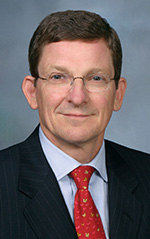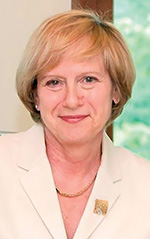Toward a More Modern Foreign Service: Next Steps
A State Department reform push is now moving into Phase III with a practical vision. Here is an update.
BY MARC GROSSMAN AND MARCIE RIES

Just over two years ago, in a discussion moderated by the American Foreign Service Association President Eric Rubin and published in the January/February 2021 Foreign Service Journal, we argued that meeting the most serious challenges the United States faces around the globe requires a continuing lead role for America’s diplomats.
The return of great power competition, preparation for the next pandemic, climate change, rules for new frontiers such as artificial intelligence and machine learning, space, and the Arctic are among the challenges that must be met by focused and vigorous American diplomacy. U.S. diplomacy and U.S. diplomats played a critical role, for example, in forging the strong and united Western response to Russian President Vladimir Putin’s invasion of Ukraine.
We said then, and we repeat today: We are proud of the men and women, Foreign Service and Civil Service, who serve our great country abroad. But America’s representatives need more support. We said that our nation’s diplomatic service “was facing one of the most profound crises in its long and proud history.” It was “underfunded and understaffed and in need of stronger career and non-career leadership.” Its record on diversity and inclusion did not match its aspirations. We argued that the Foreign Service needed an honest self-assessment of an internal culture that is often an impediment to individual and organizational success.
The conclusions we shared then were based on work we had done with Nick Burns, now U.S. ambassador to China, for the November 2020 report, A U.S. Diplomatic Service for the 21st Century, published by the Harvard Kennedy School’s Belfer Center for Science and International Affairs with the participation of the Una Chapman Cox Foundation and individual donors. In that nonpartisan report, we presented 10 actions to reimagine the U.S. Foreign Service. We focused on reform of everything from the Foreign Service mission and mandate to the need for more professional education and training, more modern personnel management, a relentless focus on diversity and inclusion, reexamination of the Foreign Service’s culture, a surge capacity in major crises with a reserve corps, and a new name, the United States Diplomatic Service, to reflect more accurately the mission and better connect diplomats to the American people.
As we had hoped, the report sparked plenty of discussion. Many recognized that 40 years after passage of the Foreign Service Act of 1980, which provides the structure of the current Foreign Service, it was the right time to identify what about the Foreign Service needed to be upgraded, modernized, or changed to meet contemporary challenges.
In a speech in October 2021, Secretary of State Antony Blinken outlined his thinking on reform of diplomacy. Groups large and small, including several embassies, the World Affairs Council of America, several bipartisan groups of Hill staff, and AFSA, invited us to discuss our ideas.
We are encouraged that some of the reforms we advocated have been adopted. They include: appointment of a State Department coordinator for diversity and inclusion, a down payment on a training “float” or complement, paid internships that will broaden the socioeconomic base of future applicants, more leadership positions for career officers through incorporating deputy assistant secretary positions in the open assignments process, new parameters for risk management, and plans for career-long education for both the Foreign Service and Civil Service.
Phase II—Not a “Report”
After the positive response to the Belfer report, our conversations with members of the outgoing Trump and incoming Biden administrations, current and retired members of the Foreign Service, important groups like AFSA, and members of Congress and staff, we decided that in a Phase II effort we would focus on four achievable, affordable, urgently needed, high-impact recommendations.
The Cox Foundation again agreed to participate. Arizona State University’s Leadership, Diplomacy and National Security Lab became our institutional home and provided crucial support, as did the American Academy of Diplomacy.
We are encouraged that some of the reforms we advocated have been adopted.
Phase II turned out to be not a “report” at all. Our Blueprints for a More Modern U.S. Diplomatic Service, released last September, are detailed plans, drafted by retired ambassadors with decades of experience, ready to be implemented as specific reforms. Each one includes proposed legislative or regulatory language written by an experienced legislative drafter. We appreciate the support AFSA has shown for the Blueprints in the FSJ.
The Blueprints cover four areas:
- A revised mission and mandate for the Foreign Service and a new framework for communicating with the American public;
- Expanded professional education and training to deepen our diplomats’ expertise as leaders and preeminent experts, and a plan to create sufficient positions to make it possible;
- Modernization of the personnel system to build in more diversity, accountability, flexibility, and accommodation of the needs of accompanying families and partners at home and overseas; and
- A plan for a diplomatic reserve corps to provide surge capacity in geopolitical crises and natural disasters.
Why Mission and Mandate
A topic that came up frequently was chief of mission authority. Since 9/11, the role and authority of U.S. ambassadors have at times been challenged or overridden, leading to confusion and a lack of cohesiveness in some embassies. The process of nominating and confirming ambassadors is unpredictable and slow, leaving many embassies without an ambassador for months or even years.
In Blueprint 1, we propose a new updated draft presidential letter to ambassadors as the clearest way to reaffirm ambassadors’ responsibilities and authorities to direct U.S. government personnel and resources abroad, as well as adding new areas of responsibility and emphasis. The new draft highlights diversity and inclusion in our embassies as a presidential priority and a chief of mission responsibility. Another passage directs ambassadors to take responsibility for risk management and to prioritize the safety of their missions while also conducting critical business, even in crisis situations.
Another proposal gives the State Department chairmanship of interagency groups addressing foreign policy at the assistant secretary level, putting to best use the knowledge that the Foreign Service brings to those deliberations.
A companion study to our Blueprints published by the Rand Corporation in 2022, The Foreign Service and American Public Opinion, concludes that while Americans have a generally favorable view of their diplomatic service, they know very little about it. The Mission and Mandate Blueprint has a cost-effective plan to get the Foreign Service out to speak to American audiences by combining it with home leave, paying expenses, and including family members.
The Case for More Professional Education and Training
Blueprint 2 begins: “State Department leadership of American diplomacy in an increasingly complex and dangerous world depends on several factors, crucially having personnel with the right skills, knowledge, and experience in the right places at the right time to advance national security interests.”
But the Foreign Service today is underfunded by about 300 positions needed to support even existing education and training. These represent largely overseas positions left vacant until training is finished. The consequence is that supervisors are reluctant to authorize staff training, and the Foreign Service culture has it that going off to training does not help—and may even hinder—promotions.
The goal of our blueprint format, including legislative and regulatory language, is to show that these reforms are achievable and affordable.
We believe there are two keys to getting this right: First, we propose that Congress fund a training and education complement (positions set aside by law for professional education and training) equal to 8 percent of the direct hire workforce. (The department is currently looking at how to do something similar for the Civil Service.) Additional funding for the Foreign Service Institute to support longer or additional courses would also be part of a budget request.
The aim is to create conditions for career-long education and training at regular intervals, directed at developing more sophisticated leadership and management skills, as well as strategic perspective, greater area knowledge, and more advanced language skills.
Second, the Foreign Service culture must change. The cultural biases against professional education and training will be hard to overcome, but they must be for the Service to earn its way back into the center of foreign policy creation and execution. We suggest that a full commitment to long-term training requires a more rigorous approach to evaluating performance in classes, changing promotion precepts to include educational achievement and giving consideration to relevant educational achievement in assignments.
A More Modern and Flexible Approach to Personnel Management
The ability of the State Department to hire and retain the highest-quality personnel who best represent the country’s diversity is the foundation of American diplomacy. Yet the State Department has devoted only modest resources to recruitment, largely through the Diplomats in Residence program and fellowships, and has taken only a few steps aimed at retention.
In Blueprint 3, we recognize that diversity in the Foreign Service is linked to recruitment. We propose more resources for hiring a recruitment staff to provide information on the Foreign Service to younger potential FS candidates across a wider geographic area.
One aspect of retention is the prospect for career officers of a reasonable timetable for merit promotion and the realistic possibility of competing for top-level positions.
In the military, you can’t become a general if you haven’t been a colonel first. Yet many deputy assistant secretary positions, an important first policy-level position, are “reserved” for political appointees. Our blueprint suggests giving diplomats leadership and management experience to prepare for higher-level positions by making more opportunities to serve as deputy assistant secretaries and making the process of selection more transparent. Putting these positions into the open assignments process is a good first step.
In the same spirit, we would reserve some assistant secretary positions and several at the under secretary level, including the Director General and the under secretaries for political affairs and management, for career officers.
Finally, in acknowledgment of the needs of family members and partners, both professional and personal, we propose ways to expand their opportunities to work in Washington, D.C., and abroad.
Time for a Diplomatic Reserve Corps
When a crisis is coming or raging, today’s State Department must cobble together resources from existing requirements, seeking the support of retirees, deploying a limited range of temporary employment authorities, or turning to expensive contractors. We admire the courageous and hard work people have done to meet these emergencies, but ad hoc is not the answer.
Unlike the military, which has the Reserves and the National Guard, the State Department has no institutional backstop to deploy in an emergency.
The cultural biases against professional education and training will be hard to overcome, but they must be.
Blueprint 4 proposes (and provides 77 pages of legislation to establish) a 1,000-person Reserve Corps that could be fully staffed via recruitment of 250 people during each of four years. Individuals would be recruited for their skills based on regional assistant secretaries’ best projection of what would be needed in a crisis.
They would train like the National Guard and Reserves and could be called up at any time.
We are delighted that this blueprint has generated interest. A requirement that the State Department prepare a report on “a reserve” appears in the recent National Defense Authorization Act, which includes the State Department Authorization Act. We are encouraged by this indication of openness to change and call on the State Department to respond positively.
What Next?
The goal of our blueprint format, including legislative and regulatory language, is to show that these reforms are achievable and affordable if there is the will to go forward.
Our next goal (Phase III) is to get them implemented. We are honored that the Una Chapman Cox Foundation and Arizona State University are again participants in this quest. The American Academy of Diplomacy will act as the executive agent for the effort.
We remain committed to full transparency with the State Department, interested congressional members and staff, and the larger foreign affairs community, very much including AFSA.
Our nation faces serious global challenges. We believe that Americans recognize that most of these challenges can be successfully overcome only if they are met with the world’s best diplomacy.
The United States needs a thoroughly modern U.S. diplomatic service to effectively promote and protect American interests in today’s dangerous world. The four blueprints are designed to help provide the American people with the high-functioning service they should demand and that they deserve. To achieve this goal, we will need the active support of AFSA and its members.
When sharing or linking to FSJ articles online, which we welcome and encourage, please be sure to cite the magazine (The Foreign Service Journal) and the month and year of publication. Please check the permissions page for further details.
Read More...
- “A Diplomacy for the 21st Century: Back to the Future?” by Marc Grossman, The Foreign Service Journal, September 2014
- “The Future of the Foreign Service” panel with AFSA President Eric Rubin, Ambassadors (ret.) Nicholas Burns, Marc Grossman, and Marcie Ries, The Foreign Service Journal, January-February 2021
- “On Moves to Modernize: An Interview with Secretary of State Antony Blinken,” The Foreign Service Journal, January-February 2022
- “Exploring the Secretary’s Modernization Agenda: A Q&A with Policy Planning Director Salman Ahmed,” The Foreign Service Journal, March 2022






